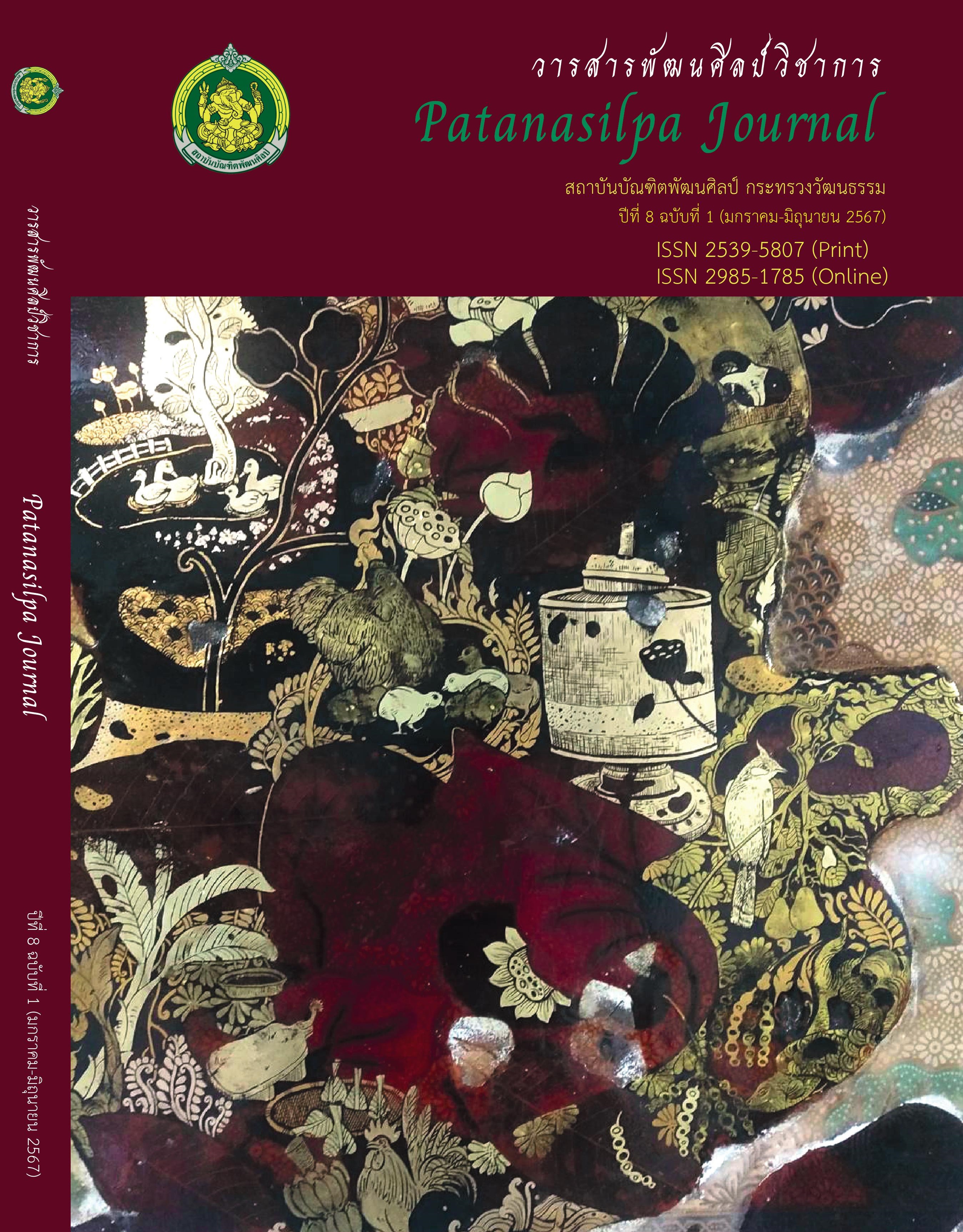การศึกษาอนุภาคทางคติชนวิทยาและบทบาทหน้าที่ในสังคมไทย ของบทเพลงที่เกี่ยวกับพระเกจิอาจารย์
-
คำสำคัญ:
อนุภาคทางคติชนวิทยา, บทบาทหน้าที่, พระเกจิอาจารย์, บทเพลงร่วมสมัยบทคัดย่อ
บทความวิจัยนี้มุ่งศึกษาอนุภาคและบทบาทหน้าที่ในสังคมไทยของบทเพลง ที่เกี่ยวกับพระเกจิอาจารย์ในภาคกลางของไทย ผู้วิจัยใช้กลุ่มข้อมูลจำนวน 4 เพลง โดยเลือกจากปีที่เผยแพร่เพลงนั้น ๆ 1 ปี ต่อ 1 เพลง ตั้งแต่พุทธศักราช 2562-2565 จำกัดเฉพาะเพลงที่กล่าวถึงพระเกจิอาจารย์ในภาคกลางของไทย ได้แก่ เพลงวอนหลวงพ่อรวย เพลงขอพรหลวงพ่อเพี้ยน เพลงหลวงพ่อไปล่ และเพลงคาถาขุนแผน (หลวงพ่อกวย) ตามลำดับ โดยใช้วิธีวิทยาทางคติชนวิทยา ได้แก่ การศึกษาอนุภาคทางคติชน วิเคราะห์ ถึงอนุภาคในเนื้อหาของบทเพลง จากนั้นวิเคราะห์ด้วยทฤษฎีบทบาทหน้าที่ ของวิลเลียม บาสคอม ผลการศึกษาพบว่าอนุภาคทั้ง 4 เพลงมีอนุภาคครบทั้ง 3 ประเภท คือ 1) ตัวละครและสถานที่ 2) วัตถุ สิ่งของหรือสิ่งแทน และ 3) เหตุการณ์หรือพฤติกรรม โดยพบว่า มีอนุภาคร่วมกันที่น่าสนใจ แสดงให้เห็นถึงความเป็นธรรมชาติและวัฒนธรรม ในขณะปัจจุบันของมนุษย์ที่ส่งถ่ายผ่านงานวรรณกรรมประเภทนี้โดยเฉพาะ ส่วนการศึกษาบทบาทหน้าที่ของบทเพลงที่เกี่ยวกับพระเกจิอาจารย์ในภาคกลางของไทยนั้น พบว่า มี 4 กลุ่ม ได้แก่ 1) บทบาทด้านการสืบทอดและเผยแพร่ประวัติพระเกจิอาจารย์ 2) บทบาทด้านการสืบทอดและเผยแพร่ความเชื่อ ความศรัทธาต่อพระเกจิอาจารย์ 3) บทบาท ด้านการสืบทอดพิธีการบูชาพระเกจิอาจารย์ และ 4) บทบาทด้านการสร้างความบันเทิงและคลายความทุกข์ใจ ทั้ง 4 กลุ่มนี้สะท้อนให้เห็นพันธกิจของบทเพลง อันนับเป็น คติชนวิทยากลุ่มหนึ่งในวัฒนธรรมที่มีมากกว่าด้านเศรษฐกิจและการค้า ทำให้เกิดมุมมอง ต่อความเป็นไปด้านสังคมได้อย่างชัดเจน และยังแสดงความคิดอันเป็นสากลของ การสร้างสรรค์วรรณกรรมของมนุษย์ตามบริบทสังคมร่วมสมัยได้อีกด้วย
References
กิ่งแก้ว อัตถากร. (2519). คติชนวิทยา. กรุงเทพฯ: หน่วยศึกษานิเทศก์ กรมการฝึกหัดครู.
ขวัญใจ บุญคุ้ม. (2559). วัจนลีลาและบทบาทหน้าที่ของเพลงลูกทุ่ง. วิทยานิพนธ์ปริญญาศิลปสาสตรมหาบัณฑิต คณะมนุษยศาสตร์และสังคมศาสตร์ มหาวิทยาลัยราชภัฏเชียงใหม่.
ฐิตินัน บ. คอมมอน. (2555). “เพลงและอัตลักษณ์วัฒนธรรมชุมชน : จรัล มโนเพ็ชร กับบทบาทของนักรบทางวัฒนธรรมดนตรีล้านนา”. วารสารนิเทศศาสตร์ธุรกิจบัณฑิตย์, 6, 2: 145-179.
ประคอง นิมมานเหมินทร์. (2551). นิทานพื้นบ้านศึกษา (พิมพ์ครั้งที่ 3). กรุงเทพฯ: สำนักพิมพ์แห่งจุฬาลงกรณ์มหาวิทยาลัย.
ปรียา หิรัญประดิษฐ์, (2533). ศิลปะการละเล่นและการแสดงพื้นบ้านในสังคมไทย. นนทบุรี: โรงพิมพ์มหาวิทยาลัยสุโขทัยธรรมาธิราช.
พิทักษ์ เผือกมี. (2563). “ศึกษาการเปลี่ยนแปลงค่านิยมในสังคมไทยผ่านบทเพลงไทยลูกทุ่ง”. วารสารพุทธสังคมวิทยาปริทรรศน์, 5, 2: 54-69.
“เพลงขอพรหลวงพ่อเพี้ยน”. (2563). [ออนไลน์]. ค้นเมื่อ 10 มิถุนายน 2566. เข้าถึงจาก https://www.youtube.com/watch?v=GiXBppY6XgU
“เพลงคาถาขุนแผน (หลวงพ่อกวย)”. (2565). [ออนไลน์]. ค้นเมื่อ 10 มิถุนายน 2566. เข้าถึงจาก https://www.youtube.com/watch?v=SyjQvKRSCUU
“เพลงวอนหลวงพ่อรวย”. (2562). [ออนไลน์]. ค้นเมื่อ 10 มิถุนายน 2566. เข้าถึงจาก https://www.youtube.com/watch?v=w0GDEgCAsWk
“เพลงหลวงพ่อไปล่”. (2564). [ออนไลน์]. ค้นเมื่อ 10 มิถุนายน 2566. เข้าถึงจาก https://www.youtube.com/watch?v=mYhIjA-g8zQ
รัชชานนท์ จิตรีสรรพ และนรุตม์ คุปต์ธนโรจน์. (2562). อนุภาคและแบบเรื่องของเรื่องเล่าสยองขวัญ สมัยใหม่ในแอปพลิเคชันจอยลดา. ใน อำรีรัตน์ แย้มเกสร (บ.ก.), งานประชุมวิชาการระดับชาติ มหาวิทยาลัยรังสิต ประจำปี 2562 (น. 972-983). มหาวิทยาลัยรังสิต.
ศิราพร ณ ถลาง. (2563). ทฤษฎีคติชนวิทยา : วิธีวิทยาในการวิเคราะห์ตำนาน-นิทานพื้นบ้าน (พิมพ์ครั้งที่ 4). กรุงเทพฯ: สำนักพิมพ์แห่งจุฬาลงกรณ์มหาวิทยาลัย.
สายป่าน ปุริวรรณชนะ. (2555). อิทธิปาฏิหาริย์กับการสร้างเรื่องเล่าศักดิ์สิทธิ์: ขนบนิยมและพลวัตในประวัติพระเกจิอาจารย์ในสังคมไทยภาคกลาง. วิทยานิพนธ์ปริญญาอักษรศาสตรดุษฎีบัณฑิต คณะอักษรศาสตร์ จุฬาลงกรณ์มหาวิทยาลัย.
สุกัญญา สุจฉายา. (2549). การศึกษาบทบาทหน้าที่ของคติชน. ใน สุกัญญา สุจฉายา (บ.ก.), พิธีกรรม ตำนาน นิทาน เพลง : บทบาทของคติชนกับสังคมไทย (น. 1-10). จุฬาลงกรณ์มหาวิทยาลัย.
Bascom, W. (1965). The Study of Folklore. New Jersey: Prentice – Hall.
Downloads
เผยแพร่แล้ว
ฉบับ
บท
License
Copyright (c) 2024 วารสารพัฒนศิลป์วิชาการ

This work is licensed under a Creative Commons Attribution-NonCommercial-NoDerivatives 4.0 International License.
บทความที่ได้รับการตีพิมพ์เป็นลิขสิทธิ์ของ สบศ.





